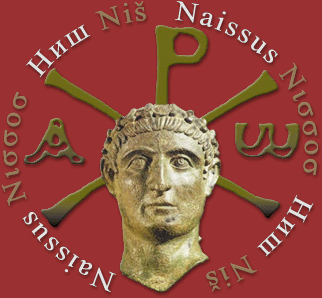

THE SCIENTIFIC SYMPOSIUM OF BYZANTOLOGIST
"NIŠ AND BYZANTIUM - IV"
in the honour of Gabriel Millet
Within the framework of celebrating the Festivities of Saint Czar Constantine and Czarina Helena the City of Niš organized the fourth international scientific symposium "Niš and Byzantium", that this year was dedicated to the eminent byzantologist Gabriel Millet.
The Scientific Board members' efforts and enthusiasm jointly with the concomitant City services resulted in the regular press edition of the Work collection "Niš and Byzantium - III" and its electronic version - CD, simultaneously with the organization of the fourth meeting of the renowned byzantologists.
Over 50 eminent experts in the field theme "Niš and Byzantium" from all over Europe and USA applied to participate at the fourth international symposium "Niš and Byzantium". Due to the limited capacities, the Scientific Board made the selection of the received applications and invited 36 eminent scientific workers from France, USA, Italy, Hungary, Poland, Greece, Bulgaria, Croatia, Macedonia as well as the domestic.
The Symposium was held at the Niš University Hall. The following exhibition of the students' works from the special program Architecture History and Theory of the Architectonic Faculty in Belgrade - "Arheological Park Medijana - a possibility for renewal and presentation" was opened by the City architect Mr. Jovan Mandic. Also, thanks to Mrs. Dominique Couson-Desreumaux, the exhibition of reproduction photos and drawings of Gabriel Millet, now belonging to the Gabriel Millet Institute of Sorbonne Collection, was set up in the hall.
The opening ceremony started with the bless of the Bishop of Niš Mr. Irinej and the welcome speech of the Mayor of Niš. The symposium was opened by the president of the Macedonian Academy of Sciences and Arts - prof. dr Cvetan Grozdanov. The representative Work collection and CD of the last year gathering "Niš and Byzantium III" was presented by Oliver Tomic.
The special guest Mrs. Dominique Couson-Desreumaux (Sorbonne -Paris) presented the details of Millet's work with the particular regard to Gabriel Millet's significance for the Serbian Art History.
Gabriel Millet, the French academic, the associate of the Serbian Academy of Sciences and Arts, the honourable member of the Belgrade University, one of the founders of byzantology as a science, especially was meritorious for Serbian architecture history. We should mention the periodical review and the typology of the Serbian medieval architecture that has been kept till today. Therefore, everyone who seriously deals with architecture has to be familiar with his capital work piece "Old Serbian Church Art", printed in Paris in the far 1919. The author himself dedicated the book to the "Serbian people" as it is said on the first page. Feeling grateful, we dedicated "Niš and Byzantium IV" to Gabriel Millet. The symposium participants' (architects, archeologists, art historians, teologists, classic philosophers, literature historians, philosophers…) works are a great deal based on the knowledge and data discovered by Gabriel Millet.
The presenters had at disposal the video-bim, the slide projector as well as the very modern equipment for simultaneous interpretation to/from English and French. On the last day the reception at the City Hall of Niš was organized for all participants as well as a site visit tour of the local cultural monuments.
To the end of the year the Work Collection No.4 will be published with the CD. The representative look and the scientific elitism of the Work Collections has to be maintained.
According to the participants impressions and broader scientific public reactions, this year byzantologists' meeting was successful. The City of Niš is surely becoming recognizable as a center of the Byzantine studies research. The tradition, international relations, gained renown and the scientific importance of the presented works enabled the Niš symposium to be included in the list of the world byzantologists' congresses. The symposium reputation and significance are best illustrated by the number of the scientific workers who independently applied for it, and which overcame the expectations and possibilities of the planed capacities.
All of these obligate us to keeping the tradition of the eminent byzantologists meeting in our city in what we will be supported by the researchers from Europe and America who have already taken part at the symposium NIŠ AND BYZANTIUM, through their precious knowledge and authority.
Miša Rakocija
Translated by Ana Mišić, coordinator

![]()


